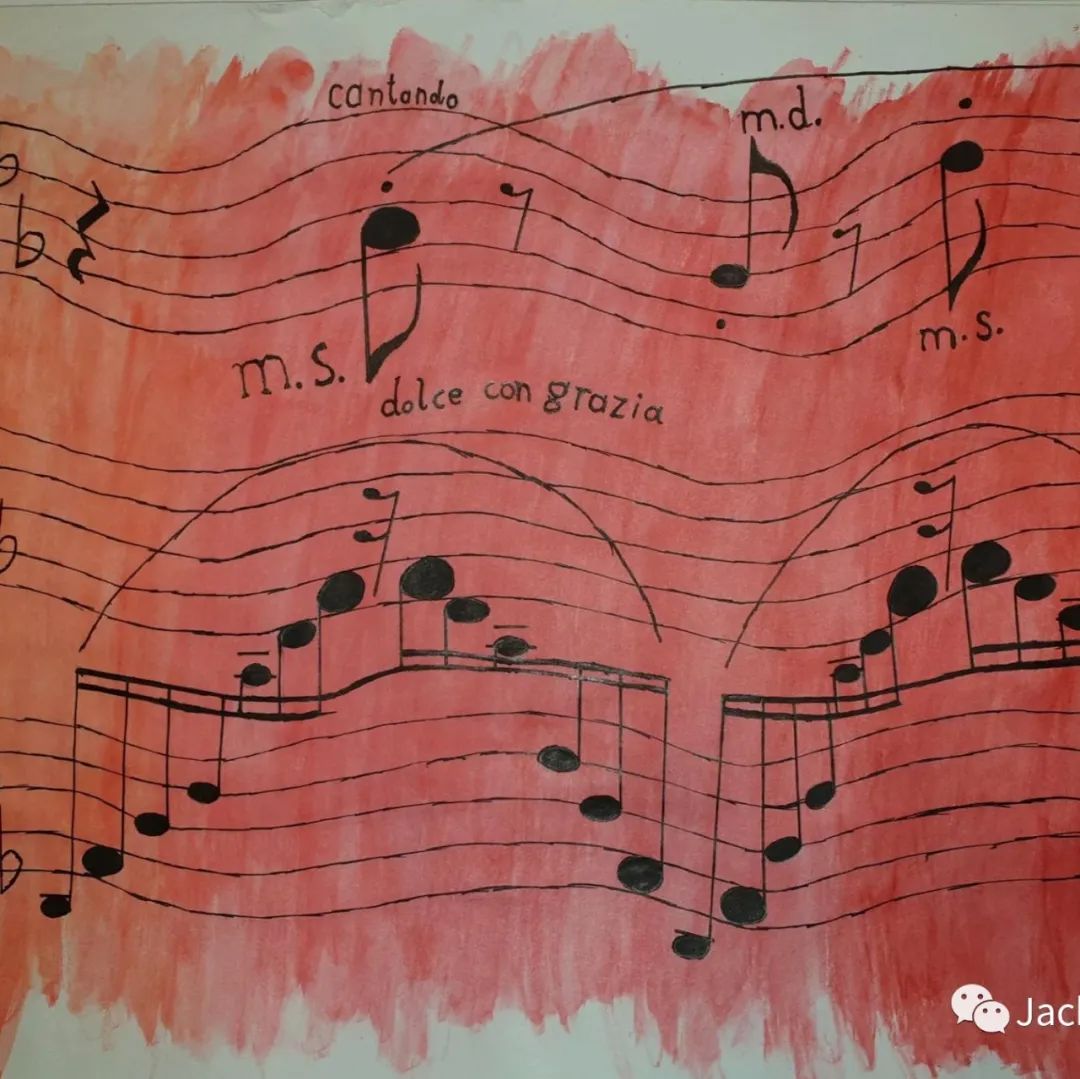Between Music and Love... 音乐与爱情
Music always provides me with endless inspiration. In the article posted on February 1st this year, I elaborated on the connection between music and writing, arguably two of the primary forms of human expression. As an extension of that article, in this one, I am going to elaborate on the similarities or connections between great music and great love. From my point of view, both great music and great love should involve free bonding in the most natural way; the most natural is the most perpetual.
When we listen to music, especially those from the Romantic period, whether an orchestral piece or a solo piece, we can discover that the melody and accompaniment parts collaborate exceptionally naturally. It is as free, easy as flowing water and does not possess any forceful signs of stagnation or obscurity. One of the best pieces of evidence is “Un Sospiro,” a piano étude composed by Franz Liszt. A pertinent piece of evidence is at the very start of the piece, from around 0:00 to around 0:38, the melody that floats on top is well harmonized with the accompanying notes in the lower octaves, like the tides of an ocean rushing ebbing. The overall structuring of the textures of this piece is fluent and inartificial. The melody and accompaniment, the rhythm and the meter, the turns and joints are all natural and intriguing. The rhythm, in particular, can swing around the meter; the meter can change to the rhythm……The audience would even feel that every combination of notes in this piece is the best. There cannot possibly be a better choice. Conversely, if the harmonies and notes of the accompaniment are “coerced” to fit with the melody line, if the rhythm is “compelled” to fit with the regular beats of the meter, or if a bond between elements can only be held with the struggling efforts of one element, the inherent beauty, equilibrium, and grace of classical music would cease to exist.
An excellent romantic relationship, I believe, must similarly be spontaneous and natural. If a relationship is not formed naturally or spontaneously and requires one side to continually put in the effort, it will be rigid and demanding. It cannot be sustainable either. In real life, we always observe “unhealthy” relationships, under which one side often pays much devotion to adhering or playing up to the other side. This kind of love relationship is like in music. When the rhythm has to conform with the meter, it is doomed for failure, as neither side can benefit or grow. This awkward relationship depletes all of a person’s vitality and spirit. To form a great relationship, there has to be a direct pure mutual share of responsibilities, and each person has to coordinate and collaborate with the other to harmonize.
Of course, beautiful romance does not mean there should be no conflict. Quite on the opposite side, conflict usually brings deeper emotional experiences to us. In conflict, we usually learn how to understand and forgive, making the relationship more profound truly. This point is well-corroborated in music. In Romantic music, we begin to hear dissonant chords or notes, and they gradually become one of the integral parts of the music. I think dissonance adds fresh experience, meaning, and value to music. It shows that true romance involves multiple aspects and multiple dimensions. Only by experiencing dissonance can the harmony or the actual implications be more fully interpreted. Take the example of “Un Sospiro” again. Liszt wrote several continuous dissonant chords in the middle section, where there is a substantial rise in dynamics. These chords seem to not fit with the world the beginning creates, but it is undeniable that they bring novel experiences and more facets of emotion into the piece. A better example of the power of dissonance is Chopin’s “Piano Sonata No.2 Fourth Movement”, which is commonly regarded as his most dissonant piece. However, one can seek out new value and meaning amongst the dissonance. Schumann, one of the most prominent musical commentators of his time, remarked that the movement is like a mighty hand suppressing a rebellious soul. It makes the horrifying ghost talk with us. Anton Rubinstein, a pivotal figure in the Russian music world, commented that the fourth movement is the “wind howling around the gravestones.” The atonality of the piece certainly created room for further interpretation and imagination, for a further deepening or extension of emotions.
Erich Fromm once claimed that love is an art in itself. If people want to learn love, they have to learn it like other arts. I believe great love is like great music, free and easy. Great love means that both people need to be like the musical elements, cooperating naturally and freely performing for the relationship. Music and love all contain conflict. We should show no fear. Conversely, we should realize that the conflict and dissonance made music and love impactful and profound. All in all, brilliant music and love are all worthwhile journeys to meet and experience in this world!
WORKS CITED
Jay_Implicit. “Franz%20Liszt%20Un%20sospiro%20(A%20sigh)%20%E9%83%8E%E6%9C%97%E7%89%88.” Bilibili.com, 23 Oct. 2018, www.bilibili.com/video/BV11t411R7EE/. Accessed 9 Apr. 2022.
音乐总是给我很多的灵感,在今年2月1日发表的关于 "音乐与写作 "的文章中,我论证了音乐和写作这两种表达方式的相互关联。作为那篇文章的延伸,在这篇文章中,我将谈一谈好的音乐和好的爱情有哪些相通之处。在我看来,好的音乐和好的爱情都应该是以最自然的方式自由结合在一起的,最自然的东西方可长久。
当我们聆听音乐,尤其是许多浪漫主义时期的乐曲,无论是管弦乐曲还是单个乐器演奏的乐曲,我们可以发现,旋律与伴奏均配合地极其自然,如行云流水般自由洒脱,不见任何费力斧凿的凝滞和晦涩。最好的例子之一是最近我非常喜欢听的一首李斯特的钢琴练习曲 《Un Sospiro》(一声叹息)。以乐曲的开始部分为例,从0:00至大约0:38,漂浮在上面的旋律与低八度的伴奏音符很好地协调起来,如海阔天空之下的潮起潮落。整首曲子的结构自然流畅,旋律和伴奏、节奏和节拍、转折和衔接,都非常自然、非常漂亮,节奏围绕着节拍摆动,节拍随着节奏的变化而变动......,甚至听众会有一种感觉,每一个音符的流动组合都是最恰当的,不可能有更好的选择了。相反的,如果伴奏的和声和音符必须被迫和旋律线吻合,或者节奏必须被强迫与节拍的固定规律吻合,再或者一个纽带只能通过一个元素的艰苦努力来实现,那么音乐听起来会是多么的生涩和僵硬,古典音乐特有的优美、均衡、典雅将不复存在。
一段好的感情我想也应该是自发和自然的。如果一种关系不是自发和自然形成的,它需要一方持续地、费力地来维系和努力,它将是非常僵化和困难的。当然,它更不可能是持续和长久的。在现实生活中,我们经常能看到一些不健康的关系,一方总是竭尽所能的附和和讨好另一方,这就像音乐中的节奏必须强行符合节拍一样。这样的感情注定是失败的,因为双方都不能从这段关系中获益和成长,相反的,它耗尽了人的精力和元气。要形成一段好的感情,必须有一个直接纯粹的相互分担的责任,每个人都必须调整并与对方自然的合作才能和谐。
当然,好的感情并不是说不能有任何的矛盾和冲突,恰恰相反,矛盾和冲突往往能让我们有更深的情感体验,在矛盾和冲突中我们往往学会更多的理解和包容,从而使情感更具深刻性,这一点在好的音乐中同样有很好的例证。在浪漫主义时期的音乐中,我们总能听到不谐和的和弦或音符,它们是音乐中不可缺少的一部分。事实上,我认为,不谐和的声音为音乐增加了更新的体验、意义和价值。它表明,真正的浪漫涉及多个方面,多个维度,只有通过体验不和谐的声音,才能更好地欣赏和谐与作品背后的实际意义。我们还是以李斯特的《Un Sospiro》为例,在接近高潮的中间部分,李斯特写了很多不谐和的和弦。这些和弦非但没有破坏乐曲的整体浪漫感觉,反而带来了新鲜的体验,带来了更多的情感面。一个更生动的例子是肖邦的《第二钢琴奏鸣曲第四乐章》,这也是被世人所认为在他的所有创作中具有最不和谐性质的乐章。然而,正是在不和谐中,新的价值和意义才方可被找寻。舒曼曾评述道:“这是非旋律,没有欢乐的乐章,像是强有力的手压抑了叛逆的灵魂,使那特别恐怖的幽灵与我们对话”。克拉克也认为:“像是秋风吹散枯叶,飘落在新墓上。”可见,该作品的无调性与不和谐为进一步的解读与想象创造了空间,进而加深或者延伸我们听时的情感。
埃里希-弗洛姆曾经认为,爱情本身就是一种艺术。如果人们想学会爱,他们必须像学习艺术一样学习它。我认为,好的爱情就像好的音乐一样意味着自由和轻松,它意味着两个人都需要像音乐中的元素一样,进行自然合作,并为这段关系自由发挥。音乐和爱情都会有不谐和与矛盾冲突,我们不要惧怕它,相反的,我们应该意识到,这些不谐和、矛盾、冲突恰恰是使音乐和情感更具冲击力和深刻性的关键因素。总之,好的音乐和好的爱情都是这世间最值得遇见的!
- 本文标签: 原创
- 本文链接: http://www.jack-utopia.cn//article/409
- 版权声明: 本文由Jack原创发布,转载请遵循《署名-非商业性使用-相同方式共享 4.0 国际 (CC BY-NC-SA 4.0)》许可协议授权










